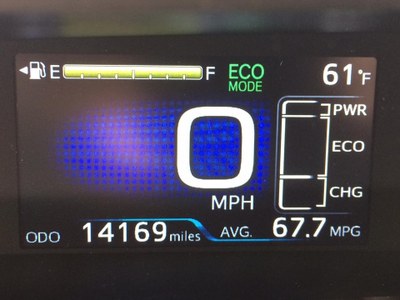In response to the 1973 oil embargo imposed by members of the Organization of Petroleum Exporting Countries (OPEC), Congress sought to reduce the nation’s dependence on oil imports by establishing Corporate Average Fuel Economy (CAFE) standards. The first standards were applied in 1975 and were intended to increase the average fuel economy of an automaker’s fleet of light duty vehicles ‒ sedans, SUVs, and pickup trucks ‒ to 27.5 mpg by 1985.
The standards have since been periodically revised, with the most recent (2009) revision calling for fleet average values of 34.5 mpg by 2016, 41.7 mpg by 2020, and 54.5 mpg by 2025. The revision was based on an agreement reached by the Environmental Protection Agency (EPA), the Department of Transportation (DOT), the U.S. automotive industry, and 12 states that advocated for higher standards. If fully implemented for model years 2017 to 2025, the standards would save 4 billion barrels of oil over the lifetime of the vehicles. However, now, under a new administration, the EPA is seeking to roll back the revisions by essentially freezing them at the 2020 level.
On the surface, it would seem that the current administration is being more realistic. After all, it would be more than a stretch to think that a manufacturer such as GM could achieve the 2025 target, especially with the growing popularity of large pickups and SUVs. Yet, GM and other automakers oppose the freeze. Why? One reason is they don’t want to deal with the risk of a fragmented market, where one group of states retains the 54.5 mpg requirement and the other adopts the 2020 freeze. Another is the belief they can actually meet the higher standard. Here’s where it gets a bit confusing.
The procedures used to determine CAFE standards were established in the 1970s by an act of Congress. They remain in effect but have not been updated to account for changes that have occurred in the vehicles themselves and in driving conditions. These changes are better reflected by the mpg ratings seen on window stickers in dealer show rooms. The net effect of differences between the procedures is that CAFE standards can be met by much lower sticker mpg ratings. So, is a CAFE standard of 54.5 mpg by 2025 really much of a stretch?
Providing credit for changes in power demands associated with air-conditioning and an array of vehicle electronics, 54.5 mpg drops to about 50 mpg. Accounting for actual on-road conditions drops it further to 37 mpg. And, if electric vehicles comprise 5% of new vehicles by 2025 - more than likely considering current trends - related credits drop the equivalent CAFE requirement to 35 mpg. Given 7 years to meet this standard, automakers should be able to get it done. But, are there good reasons for staying the course?
For one, together with increasing domestic production of shale oil, reducing fuel consumption would further reduce our dependence on imported oil and, by so doing, its effect on the nation’s large balance of trade deficit. Reducing domestic demand would also put downward pressure on the price of oil, lowering prices paid at the pump. Of course, assuming no change in driving habits, buying a higher mpg vehicle would also save motorists money by reducing fuel consumption. And, dare I mention it? There’s the added benefit of mitigating global warming. Reducing oil consumption by 4 billion barrels would eliminate release of almost two billion tons of carbon dioxide to the atmosphere.

I’m showing the following snapshot, not to underscore my commitment to energy efficiency, but to emphasize the point that meeting the 2025 CAFE standard is doable.
It was taken a month ago and shows the total mileage accumulated on my 2016 Prius and the average fuel economy. Your eyes aren’t deceiving you. The average is 67.7 mpg, well above the manufacturer’s sticker rating of 54 mpg. How is that possible?
Fuel economy depends not only on what we drive but how we drive. Over the last 20 years, my mindset has gone from that of an extremely aggressive Boston driver to that of a hypermiler, a term used to describe someone determined to extract every mile possible out of a gallon of gas. There are a number of things that can be done, beginning with slow accelerations and coasting to stop signs and traffic lights. Take a few minutes to look at this cool video of how one person does it.
In any case, the key take-away is, no matter what you drive, you can get better gas mileage by improving the way you drive. And, in so doing, there are benefits to you and the nation.